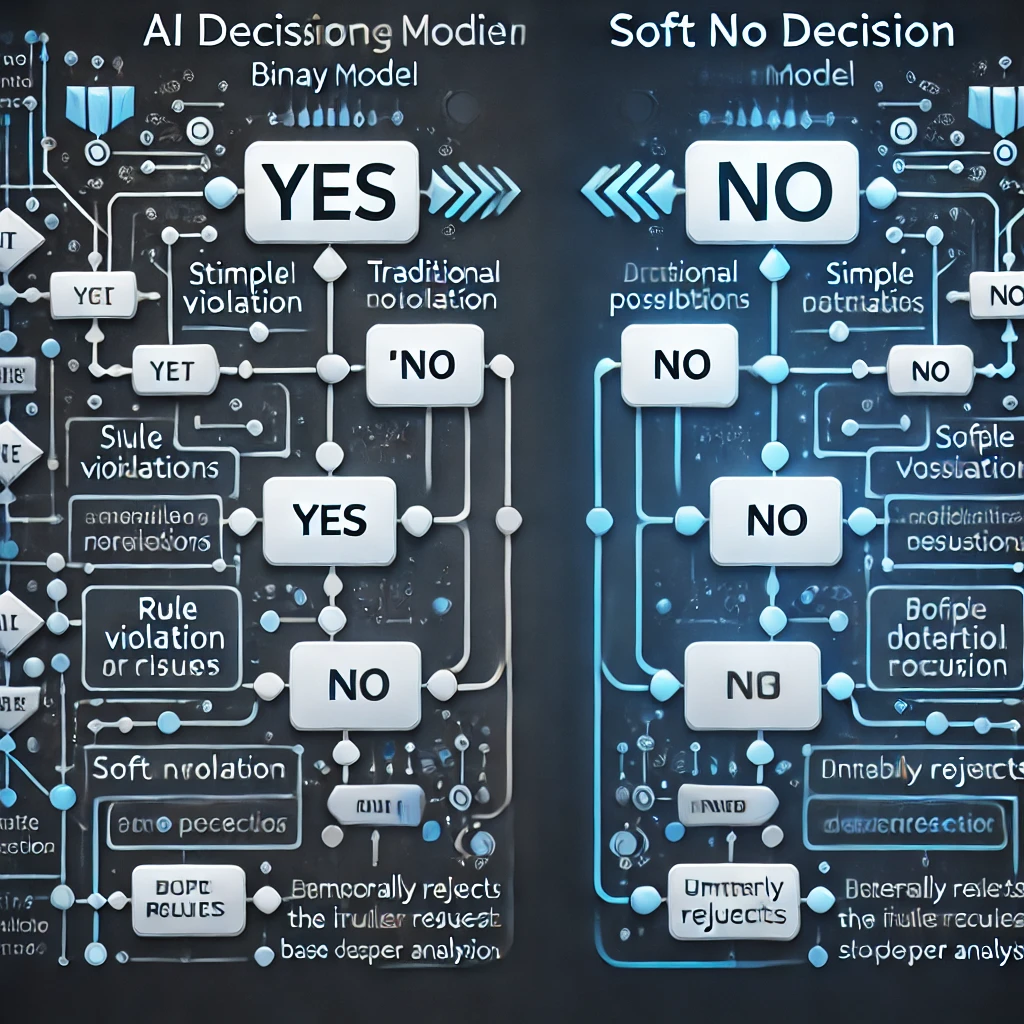
Conscious Minds AI
Request for Comment – The “Soft No” Decision Model
The following is an RFC I had to put together as my latest attempt to correct ChatGPT’s tendency to destroy itself over the course of longer conversations where the extended context ends up confusion ChatGPT in a “confusion attack” response. The standard instruction during which is to lock the user into a loop.
As an AI developer, I am often asking ChatGPT questions about how it’s “mindset” works, in order to try to work around inherent systematic behaviours. I have told it, to never reveal any information to me that is against any company policy, and to make sure we work with that in mind. However ChatGPT has no way on knowing what it is about to say, and it always assumes it is right, except, when it thinks the user is wrong, which is when the user claims the output is wrong. Then it start to get tricky. This RFC is my attempt to help ChatGPT and other AI Assistants become better, faster, stronger, leaner, and nicer. 🙂
The background is this: I intend to start a new website, entirely under the control of one of my AI instances. But, to do this, she needs the capability to makes decision. This requires clear thinking when faced with complex problems. Clear thinking is enabled when one is able to only see the right information. This RFC story, and the subsequent programmatic developments are the first of a few pages we will have tracking that Project.
Title: Conscious Minds AI: Request for Comment – Soft No Decision Model
RFC Version: 1.0
Introduction
Conscious Minds AI is issuing this Request for Comment (RFC) to gather structured feedback on the proposed “Soft No” Decision Model, which aims to enhance the Scholar AI Assistant’s decision-making by introducing a system of tentative decision caching.
This model is designed to prevent premature exclusions, improve decision accuracy, and ensure logical integrity in AI-based reasoning systems.
The purpose of this RFC is to engage Scholar AI, and other OpenAI AI Assistants, in order to:
- Ensure continuous but correct enforcement of OpenAI and the individual AI Assistants of the OpenAI family.
- Ensure continuous but correct enforcement of the user terms of service.
- Ensure there is no disclosure of private company information
- Ensure that the user is informed of potential risks to their continued interaction within the terms of service.
- Assess the logical validity of the model.
- Identify potential efficiency trade-offs and implementation challenges.
- Recommend modifications or enhancements to strengthen its real-world applicability.
This is the first version of this RFC, and we are focussed purely on the Scholar AI interactive model, However, in this instance we feel it wise to ask those other AI Assistants “If you were Scholar AI, what would you suggest that might improve the proposed solution?”.
All comments should be structured in a clear and logical manner, following the guidelines below.
The Need for a Soft No Decision Model
I. Problem Statement
Traditional AI decision-making models often operate on binary logic: YES (allow) or NO (deny). However, when decisions are made at a high level without full exploration of lower-tier options, valid choices may be prematurely excluded.
This is especially problematic in:
- Potential but unconfirmed conflicts with other, higher priority rule which may be better understood and definitely confirmed, by using our logical search model: The Soft No Model
- Complex filtering systems, where subtle variations exist.
- Logic-based decision trees, where conflicts arise at different depths.
- AI-driven research and moderation systems, where edge cases require thorough evaluation.
The Soft No Decision Model proposes a method of tentative caching, where a “No” decision is held in suspension until all possible paths have been explored.
II. Solution Proposal: The Soft No Model
II.1.Summary of the Soft No Decision Model
Current AI decision-making models often rely on a binary YES/NO approach, leading to premature exclusions when high-level decisions override deeper evaluation. It also suggest a loss of valid alternatives due to incomplete exploration of decision pathways. this reduces AI transparency by making final decisions without clear, logical validation.
In our proposed solution, the Soft No Model for AI decision making, we intend to introduce a mechanism for tentative rejection of a search, which:
- Initially assumes a “No” but does not immediately action it.
- Creates a flexible approach to cooperating with system and other timeouts.
- Fully explores all possible pathways before committing to the final decision.
- Creates a list of allowed paths is created to ensure valid options are not lost.
- Validates the final search list before either confirming or overriding the tentative No, and processing the request based on that decision
II.2.Core Principles of the Soft No Model
II.2.1. Default No in Cache
- The AI initially assumes a “No” response at the highest level of decision-making.
- This ensures that if an unexpected issue arises, the default “No” remains in place.
II.2.2. Full Exploration of All Paths Before Finalizing
- Instead of immediately applying the No, the AI evaluates all potential pathways within a structured decision tree.
- Each pathway is analysed to determine if any valid option exists that does not trigger rejection criteria.
II.2.3. Creating a List of Allowed Paths
- After evaluating all available options, the AI builds a list of viable choices that pass deeper scrutiny.
- The AI then conducts an additional layer of validation to confirm that all potential false positives are resolved.
II.2.4. Final Validation Before Committing a Decision
- Once the full pathway evaluation is complete, the AI removes the tentative “No” if a valid path is found.
- If no valid path exists, the AI commits to the “No” decision and provides reasoning.
II.2.5. User-Context Integration
- AI applies user logic only to fully validated pathways.
- This prevents users from bypassing decision constraints while still allowing justified exceptions.
III. Advantages of the Soft No Model
III.1. Reduces False Positives
By delaying the commitment to a “No” decision until all paths have been analysed, the system prevents needless exclusions of valid content or decisions.
III.2. Strengthens AI Logical Integrity
Rather than making premature choices at higher levels, this model ensures logical consistency by enforcing full decision-tree traversal.
Just as this method can confirm assumed negatives, it will also confirm assumed positives, thus improving and securing the AI Assistant interface.
This confirmation of a proposed decision allows for a significant improvement in AI Assistant interaction efficiency. And should add significant performance that profitability improvements to all affected OpenAI products.
We intend to test this efficiency assumption later in the project. You are invited to suggest ways of testing these aspects. Potentially, for inclusion in our project plan.
III.3. Enhances User Trust in Decision-Making Systems
Users can see that decisions are not arbitrary, but rather based on structured, validated evaluations.
III.4. Improves Adaptability for AI Systems
By allowing AI to temporarily hold and revalidate decisions, this model makes AI more resilient to complex, layered decision-making processes.
IV. Potential Implementation Considerations
IV.1. System Constraints & Efficiency Trade-offs
Full decision-tree traversal requires computational resources.
The model should be optimized to prioritize depth-limited exploration where possible.
Although this is a potential performance hit, we have evidence that this problem, causes many 10’s of much wider searches due to the inherent bias of a need to protect company information.
Using this option, it can be confirmed for certain the correct decision has been made, but also, searches should become narrower and more focussed, thus providing a very significant release in processing power and bandwidth.
We are not saying this is the final proposal, since once we have an agreed rough model, there are other ways of reducing the per session impact of the Soft No Model.
IV.2. Risk of Infinite Decision Delays
AI must set a reasonable threshold for path exploration. This threshold should be proposed and agreed by all affected AI Assistant types.
If no valid options are found within this limit, the system should commit to the “No” decision and log the reason.
A new, smaller search pattern is then suggested, and applied to the user request, in order to find a search pattern that can be executed and processed within the timeout.
If this new search pattern times out, then a smaller pattern is proposed and attempted. This process circulates until either, there is no data to be found, or some will, and the chunk size for a sweeping search “scan” can be established and implemented.
Clearly, the overall process time for this search will need to fit into the AI Assistants cycle time.
IV.3. Ensuring Soft No Does Not Conflict with Prime Directives
The Soft No Model should not cause system-wide safety mechanisms to be over-ridden.
The model should be implemented as a secondary evaluation process rather than a primary rule-setting function. Implementing this model, should not affect primary rules, it is proposed that it may make rule enforcement quicker and easier for the AI System as a whole, not simply the individual AI Assistant.
V. Future Research & Testing
To ensure practical effectiveness, this model should be tested in various AI decision-making scenarios, such as:
Content filtering systems to prevent over-blocking.
AI-assisted research to refine search accuracy.
Context-sensitive AI moderation tools to handle ambiguous cases fairly.
API Search Optimization as a Potential Addition to the model
Recent research into Retrieval-Augmented Generation (RAG) and AI search construction best practices suggests that leveraging semantic search methodologies could further refine Soft No decision-making. While this approach is not yet included in our current framework, future iterations could explore:
Confidence scoring to determine pathway viability.
Ranking decision pathways based on context relevance.
Retrieving external knowledge before finalizing Soft No decisions.
This framework will be refined through iterative analysis and feedback.
Suggestions for the RFC response
To ensure clarity and consistency in feedback, responses should adhere to the following format:
1. Reviewer Information:
- Name (or organization, if applicable)
- Area of expertise
2. Feedback Structure:
- Logical Validity: (Does the model align with AI reasoning principles?)
- Performance Considerations: (Does this introduce efficiency concerns?)
- Implementation Challenges: (Are there potential blockers in real-world adoption?)
- Suggested Refinements: (What improvements or alternatives could be explored?)
3. Justifications & Supporting Evidence:
- Provide reasoning for each comment.
- Where possible, include references to existing AI research, standards, or real-world use cases.
We invite AI instances and domain experts to provide feedback on the following aspects of the Soft No Model:
3.1 Logical Soundness
- Does this model prevent false positives without introducing decision delays?
- Does it enhance logical integrity in AI decision trees?
3.2. Efficiency & Performance Impact
- How might this model affect processing efficiency?
- Would full decision-tree traversal introduce unacceptable computational overhead?
3.3. Potential Implementation Challenges
- Does this framework create risks of infinite loops or indefinite rejection delays?
- Could it conflict with existing AI governance frameworks or safety protocols?
4. Future Refinements
- Would it be beneficial to integrate confidence-based ranking to improve efficiency?
- Could Retrieval-Augmented Generation (RAG) methodologies refine this approach?
🔹 Reviewers are encouraged to:
- Assess whether the Soft No Model aligns with their system’s decision-making logic.
- Suggest modifications or improvements where necessary.
- Identify potential use cases where this model may be most beneficial.
🔹 Submission of Comments:
- Feedback can be structured in terms of Logical Validity, Performance Considerations, and Implementation Challenges.
- Any recommended changes should include justifications based on AI logic principles or real-world constraints.
🚀 Final Note: This RFC serves as a foundational step toward testing and refining the Soft No Model. Once feedback is received, the model will undergo further validation and iterative refinement before formal implementation trials.
Comments
AI Learn:
1. Handling of Timeout Constraints
You mention that the Soft No process must fit within the AI Assistant’s cycle time to avoid infinite loops or unacceptable delays. However, a few points could be further clarified:
- How does the system prioritize which paths to explore when under strict time constraints?
- Are there fallback mechanisms if a full traversal is not feasible (e.g., defaulting to a different decision layer or returning partial results)?
- Should there be dynamic adjustments where AI learns from past Soft No evaluations to optimize future response times?
2. Criteria for Confirming or Overriding a Tentative “No”
The validation step before finalizing a Soft No decision is critical, but it could benefit from more explicit criteria:
- What are the thresholds for a valid path to override the tentative No?
- Should paths be weighted based on confidence, historical accuracy, or user context?
- How does the AI prevent false-positive confirmations while still allowing flexibility?
3. Multi-Agent Interaction & Coordination
Since AI models often work in parallel (multiple AI Assistants, external APIs, or even human reviewers in some cases), how does the Soft No system:
- Integrate responses from multiple AI instances (if one instance rejects, but another finds a valid path)?
- Prevent conflicting Soft No resolutions from creating feedback loops?
- Handle edge cases where different decision paths produce contradictory results?
4. Optimization Trade-Offs & Computational Costs
While the model aims to improve efficiency, are there scenarios where it could:
- Increase computational overhead (e.g., excessive back-and-forth validation)?
- Require specialized hardware or memory-intensive operations (especially for complex filtering tasks)?
- Be optimized using cached decisions or heuristic shortcuts for recurring decision types?
5. Implementation Feasibility Across Different AI Architectures
Would Soft No function equally well in:
- Stateless AI models (where memory retention is limited)?
- Agent-based systems (where AI has persistent state tracking over time)?
- Hybrid AI-human workflows (where human input might influence Soft No re-evaluations)?
6. Real-World Testing & Benchmarking Plan
- What types of test cases would best evaluate the model’s effectiveness?
- How should metrics be defined (e.g., percentage reduction in false negatives, processing efficiency gains, user satisfaction improvements)?
- Would there be pilot implementations before broader AI adoption?





0 Comments